Where to Buyreplica of Boccioni Sculpture Unique Forms of Continuity in Space
The Futurists wanted art to break from the Classical and Renaissance styles still dominant in Italy at the start of the Twentieth Century. For some, Unique Forms of Continuity in Space shows a figure striding into the future. Its undulating surfaces seem to transform before our eyes. About fifty years after Charles Darwin introduced the theory of evolution and about thirty years after Nietzsche described his "super-man," Boccioni sculpted a future-man: muscular, dynamic and driven.

Umberto Boccioni, Unique Forms of Continuity in Space, 1913 (cast 1931), bronze, 111.2 x 88.5 x 40 cm (The Museum of Modern Art, New York)
Motion as Form

Auguste Rodin, The Walking Man, 1907, cast made by Fonderie Alexis Rudier in 1913, bronze, 213.5 x 71.7 x 156.5 cm (Musée Rodin, Paris)
The face of the sculpture is abstracted into a cross, suggesting a helmet, an appropriate reference for the war-hungry Futurists. The figure doesn't appear to have arms, though wing-like forms seem to emerge the rippling back. However, these protrusions are not necessarily even a part of the figure itself, since Boccioni sculpted both the figure and its immediate environment. The air displaced by the figure's movement is rendered in forms no different than those of the actual body. See, for example, the flame-like shapes that begin at the calves and show the air swirling away from the body in motion.
This idea of sculpting the environment around a figure is expressed in Boccioni's "Technical Manifesto of Futurist Sculpture" (1912) and shows the influence of the sculptor Medardo Rosso, an Italian contemporary of Auguste Rodin who worked in Paris (and who was becoming more popular back in Italy in this period thanks to the efforts of sometime-Futurist Ardengo Soffici. Rosso made impressionistic plaster or bronze busts, covered in wax, of people in Paris, in which the figures merge into the space around them, as seen in his Impressions of the Boulevard: Woman with a Veil, 1893. Unique Forms of Continuity in Space has also been compared to Rodin's armless Walking Man of 1907.

Umberto Boccioni, Dynamism of a Soccer Player, 1913, oil on canvas, 193.2 x 201 cm (The Museum of Modern Art, New York)
Unique Forms is one of a series of sculptures of striding figures that Boccioni created in 1913. Up until 1912, Boccioni had been a painter, but after visiting Paris and the seeing sculptural innovations like Braque's three-dimensional Cubist experiments in paper, Boccioni became obsessed with sculpture. His striding sculptures continued the theme of human movement seen in his paintings such as Dynamism of a Soccer Player, 1913.
Movement was a key element for Boccioni and the other Futurists, as the technology of transportation (cars, bicycles, and advanced trains) allowed people to experience ever greater speeds. The Futurist artists often depicted motorized vehicles and the perceptions they made possible—the blurry, fleeting, fragmentary sight created by this new velocity.
Breaking his Own Rules

Giacomo Balla, Dynamism of a Dog on a Leash ( Dinamismo di un Cane al Guinzaglio), 1912, oil on canvas, 95.57 x 115.57 x 6.67 cm (Albright-Knox Art Gallery, New York)
Unlike fellow Futurist Giacomo Balla, who used repeated forms to represent movement, in work such as Dynamism of a Dog on a Leash (1912), Boccioni synthesized different positions into one dynamic figure. Although Unique Forms of Continuity in Space is the most famous Futurist sculpture, there are some aspects of the work that do not fit neatly with the artists' declarations. For example, three years before he made this sculpture, Boccioni and the other Futurist artists had banned the painting of nudes for being hopelessly mired in tradition—and Unique Forms is a nude male, albeit one abstracted through exaggerated muscles and possibly shielding its head with a helmet.
Boccioni also breaks rules from his "Technical Manifesto of Futurist Sculpture" where he declared that Futurist sculpture should be made of strong, straight lines, "The straight line is the only way to achieve the primitive purity of a new architectonic structure of masses or sculptural zones." Clearly, he had not yet recognized the potential for the dynamic curves so powerfully expressed here. His manifesto also states that sculpture should not be made from a single material or from traditional materials such as marble or bronze.
Bronze or Plaster?

Umberto Boccioni, Unique Forms of Continuity in Space, 1913, plaster (Museu de Arte Contemporânea in São Paulo)
Boccioni produced several mixed media sculptures and the original Unique Forms of Continuity in Space, was, like the majority of his sculptures, made of plaster. The bronze versions we are so familiar with are casts made long after the artist's death in 1916. The original white plaster sculpture, today in São Paulo, looks more transient and delicate than the later bronze casts, and is thus far more fitting for Futurism, since many Futurists claimed to want their works of art destroyed by more innovative artist successors, rather than preserved in a museum.

Maria Angela Cassol (signed M.A.C. on the coin) Twenty Cent Euro coin, 2002 (copyright: Repubblica italiana. Issuing authority: Ministero dell'Economia e delle Finanze)
Unique Forms appears on the Italian 20-cent Euro coin and is both Futurism's most famous symbol and a reminder that the movement itself was dynamic and did not always follow its own declarations. The Futurists sought to clear away the legacy of art's history so that the future could come more quickly, but Unique Forms has often been compared to the ancient Greek Nike of Samothrace and Gian Lorenzo Bernini's Apollo and Daphne. The Futurists wanted to destroy the museums, but in the end, their work was added to the canon of Italian sculpture.
"Museums: absurd abattoirs for painters and sculptors who ferociously slaughter each other with colour-blows and line-blows along the disputed walls!"
–F.T. Marinetti, "The Founding and Manifesto of Futurism," 1909
Additional Resources:
This sculpture at The Museum of Modern Art, NY
Ester Coen, Umberto Boccioni (New York: The Metropolitan Museum of Art, 1988)
This sculpture at The Metropolitan Museum of Art
Medardo Rosso,Impressions of the Boulevard: Woman with a Veil, 1893 (Estorick Collection of Modern Italian Art, London)
Smarthistory images for teaching and learning:

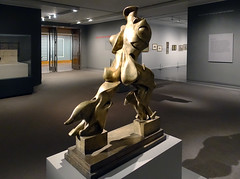
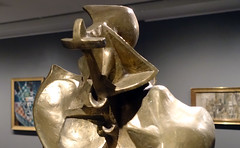
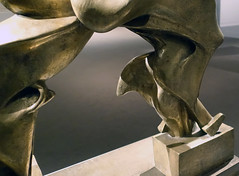
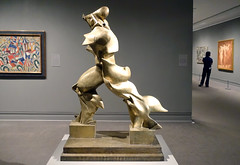
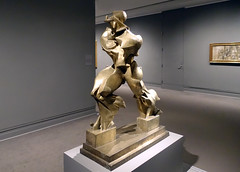
More Smarthistory images…
Source: https://smarthistory.org/umberto-boccioni-unique-forms-of-continuity-in-space/
Post a Comment for "Where to Buyreplica of Boccioni Sculpture Unique Forms of Continuity in Space"